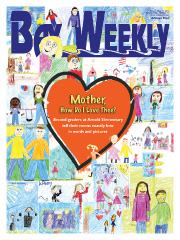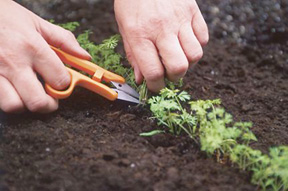Chesapeake Bay's Independent Newspaper ~ Since 1993
1629 Forest Drive, Annapolis, MD 21403 ~ 410-626-9888
Volume xviii, Issue 18 ~ May 6 to May 12, 2010
Home \\ Correspondence \\ from the Editor \\ Submit a Letter \\ Classifieds \\ Contact Us
Best of the Bay \\ Dining Guide \\ Home & Garden Guide \\ Archives \\ Distribution \\ Advertising![]()


Bay Gardener |
Don’t Crowd Your Veggies
Give each plant room, and you’ll eat bigger, better vegetables
Just because the plants are small, you don’t need to plant them shoulder to shoulder. Crowding is a common problem with beginning gardeners and, with some gardeners, remains a problem. It is not uncommon to see three to four tomato plants growing where only one should have been planted. A tomato plant that has been allowed nine square feet of space will produce many more tomatoes than plants given only four square feet of growing space.
Plants such as tomatoes, peppers and eggplants need not only adequate amount of light for each plants’ photosynthesis but also adequate air circulation around the leaves, stems and fruit to minimize disease. When plants are crowded, they compete for light, water and nutrients. Crowding also prevents air from freely circulating through the foliage. Thus foliage and fruit stay wet longer, making conditions more favorable to disease. Crowded plants need more fungicides to control diseases.

![]() Crowding is also a problem with root crops such as radishes, carrots, beets, parsnips, salsify and turnips. It is difficult to sow carrot seeds thinly because they are so small. I find mixing the carrot seeds with dry instant coffee at a ratio of one part by volume of carrot seeds and four parts by volume of dry instant coffee allows me to sow carrot seeds that will require only minimum thinning. It is possible, but more expensive, to purchase pelletized carrot seed.
Crowding is also a problem with root crops such as radishes, carrots, beets, parsnips, salsify and turnips. It is difficult to sow carrot seeds thinly because they are so small. I find mixing the carrot seeds with dry instant coffee at a ratio of one part by volume of carrot seeds and four parts by volume of dry instant coffee allows me to sow carrot seeds that will require only minimum thinning. It is possible, but more expensive, to purchase pelletized carrot seed.
To grow good carrots, you must thin the seedlings at least one to one and a half inches apart. I generally thin carrots when they are approximately two inches tall, using a small triangular scrapper. Beets and parsnips should be thinned to approximately two inches apart. Waiting to thin the beets until they are six to eight inches tall will provide you with a nice meal of beet greens.
Never transplant radish, carrot, beet, parsnip, salsify or turnip seedlings, as transplanting will result in useless branched roots.
I always find that the seeds of lettuce are best started indoors and later transplanted to the garden. Again lettuce seeds are small, difficult to handle and must be sown on the surface of the soil and kept moist for maximum germination. Lettuce seeds also need light to germinate.
Bay Gardener Recommends the Weed Bandit
Q At an Annapolis Horticultural Society meeting, you recommended a type of hoe for use in the garden because it was small enough to fit between rows. It had an unusual name, which unfortunately I now forget. I did find it online a few years ago, but was stumped by the choice of two metals offered.
Can you tell me the name of this hoe, the type of metal I supposedly should be looking for and even an online source if you know of one?
–Siobhan Percey, by email
A The hoe is called Weed Bandit, and it comes in three sizes: large, medium and small. Go to www.weedbandit.com or www.cosmos.com.
Ask Dr. Gouin your questions at [email protected]. All questions will appear in Bay Weekly. Please include your name and address.
© COPYRIGHT 2010 by New Bay Enterprises, Inc. All rights reserved.
